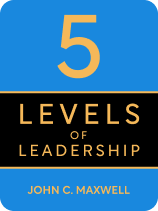

This article is an excerpt from the Shortform book guide to "The 5 Levels of Leadership" by John C. Maxwell. Shortform has the world's best summaries and analyses of books you should be reading.
Like this article? Sign up for a free trial here .
What is Level five leadership? What do you think a leader should do once they’ve reached the pinnacle of the leadership ladder?
In John Maxwell’s hierarchy, level five leadership is called the pinnacle leadership or the legacy-based leadership. At this level, people follow you because you have a reputation for developing strong leaders and strong organizations. Pinnacle leadership is about legacy—developing Level 4 leaders so that your organization continues to thrive even after you’re gone.
In this article, we’ll discuss Maxwell’s level five leadership, its upsides and downsides, and what to do to thrive at this level.
Level Five Leadership
Level five leadership, which Maxwell refers to as Pinnacle, combines everything you’ve learned, the skills you’ve honed, and your natural leadership ability to bring growth and success to an organization.
(Shortform note: Collins likewise believes that Level 5 leaders are all about building an enduring organization that will thrive long after they’re gone. After analyzing what made companies go from good to highly successful, he found that one of the distinguishing factors was the leaders. They were quiet and self-effacing but relentless when it came to getting results—their ambition was funneled towards organizational, rather than personal, success. This “company first” mentality meant that they groomed the next generation of leaders, ensuring that the company would be left in good hands.)
Pros of Pinnacle Leadership
According to Maxwell, the upsides of Level 5 are:
1. It puts your organization ahead of the pack and creates a lasting impact. Organizations that have found lasting success rely on leadership to keep them going. They don’t falter when a superstar leader moves on or retires because there are other worthy leaders who’ve been trained to take over and keep things running smoothly. Developing the next generation of leaders who will then develop the next generation of leaders creates a legacy that can last well after you’ve left.
| Succession Planning Makes Successful Companies You may be surprised how far in advance leaders of enduring companies think about succession. Preparing future leaders years ahead of time ensures there are no major disruptions at the company when a CEO leaves. You can find some examples of meticulous succession planning in Built to Last: Motorola. Founder Paul Galvin began preparing his son Bob for the leadership role while Bob was still in high school. When Bob finally took over, he immediately started planning for succession, even though he didn’t leave until 25 years later.General Electric. CEO Reginald Jones started searching for a replacement seven years prior to his departure. He had an initial list of 96 candidates, and after many challenges, interviews, and evaluations, Jones chose Jack Welch.Procter & Gamble. Richard Deupree trained under two CEOs at P&G before taking over the role. He then trained the next four people to hold the position after him. |
2. It amplifies your influence. Level 5 leaders are so highly respected that their influence extends beyond their organization and sometimes even beyond their industry. Maxwell says that this influence also means a responsibility to serve others. After going through the process of learning and then reaping rewards and recognition, pinnacle leaders now have to focus on giving back, using their influence to raise up other leaders.
(Shortform note: While Collins likewise asserts that Level 5 leaders put a lot of effort into grooming their successors, he doesn’t mention influence or a duty to serve others. Instead, he writes that Level 5 leaders see the training of future leaders as integral to preserving a company’s greatness.)
Cons of Pinnacle Leadership
Here are the downsides of Level 5, according to Maxwell:
1. You might think you’ve reached the end of your journey. Maxwell writes that as a leader at a high level, you have great influence and so the impact of your decisions affects not just you but also your organization. If you think that you can rest because you’ve finally achieved success and have nothing left to learn, it can cause your organization to lose steam. To be a Level 5 leader, you should never rest on your laurels, but keep trying to improve yourself and your organization.
(Shortform note: Executives may find it challenging to fit learning into their busy schedules. One CEO writes that you can fuel your professional growth by signing up for online courses that let you learn at your convenience, reading venture capital blogs that give trend reports and advice, and meeting with peers and mentors.)
2. You might become too full of yourself. Because so many people look up to you, you might become overconfident, which can lead to bad decisions. Be confident but stay grounded—success is never a one-person show, and there were surely a lot of people who helped you get to where you are.
- Example: Fueled by previous success, investor and hedge fund manager Ray Dalio predicted a depression and bought gold and T-bill futures to guard against the worst-case scenario—only to be proven completely wrong as the stock market began a lengthy bull run. This caused him to lose so much money that he had to let all his employees go and even borrowed money from his dad just to stay afloat. (Shortform note: Read about how Dalio turned things around and what he learned from his struggles in our guide to Principles: Life and Work.)
(Shortform note: While overconfidence can lead to reckless decision-making, research reveals some positive aspects: Overconfident executives were associated with a lower employee turnover rate, were found to be more innovative, and were more likely to develop lasting relationships with suppliers.)
3. You might lose sight of what’s important. If you reach pinnacle leadership, many opportunities will open up to you, giving you a chance to spread your influence even further. But you shouldn’t be distracted. Don’t lose your focus on the vision and the work you’re supposed to be doing, and continue to lead at the highest level.
- Example: Both Maxwell and Jim Collins in Good to Great cite Lee Iacocca as an anti-Level 5 leader. Halfway through his stint as CEO at Chrysler, Iacocca turned things around and saved the company. And then, instead of focusing on the company’s continued growth, he went on a personal victory lap, pushing his own brand: He made the rounds of talk shows, starred in commercials, considered running for president, and wrote a best-selling autobiography. He became immensely popular—but by the second half of his tenure, Chrysler had fallen far behind the general market.
| What Is Important? According to McKinsey & Company, the CEO accounts for 45% of a company’s performance. With so much responsibility and influence, CEOs are pulled in several different directions at once, so it’s easy to get distracted and lose sight of what’s important. McKinsey breaks down the six most important elements that CEOs should focus on: Corporate strategy—setting the direction for the company Organizational alignment—matching talent with roles Team and processes—ensuring the management team is strong Board engagement—maintaining good relationships with the board External stakeholders—staying true to the company’s why Personal working norms—managing the pressure that comes with the role |
Maximizing Pinnacle Leadership
While a lot of opportunities will open up to you at the highest level, pinnacle leadership is more about giving than taking. Maxwell offers these best behaviors to guide you:
1. Give others the opportunity to lead. As a Level 5 leader, you want to develop leaders, not just gain followers, and that means that you should genuinely want other people to succeed, help them work on their strengths, empower them to lead, see their potential and help them get there, and set aside enough time to mentor them.
You might think there’s only so much room at the top so developing leaders would be pointless. But when you develop leaders and find places where they can contribute, you start a cycle that fuels an organization’s growth, which in turn leads to a need for more good leaders. Find ways to create opportunities for expansion or initiatives that would require additional leaders to give them the chance to advance.
As previously mentioned, this also means that Level 5 leaders treat succession planning seriously. Maxwell believes that many leaders stay at an organization longer than they should, but that as a Level 5 leader, you should treat succession like a relay race: Pass off the baton while both you and the next person are running at full speed.
(Shortform note: In Good to Great, Collins brings up a similar point, saying that Level 5 leaders have a “company-first” mentality. They prioritize the success of the organization over personal gain, even if it means handing over the reins to someone who can keep the momentum going.)
- Example: Collins cites Fannie Mae’s CEO David Maxwell as one Level 5 leader who passed the baton while running at maximum speed. Maxwell dramatically increased the company’s earnings from $1 million a day to $4 million a day and could have used his performance and clout to stay in his position. Instead, he left when he was at his peak and entrusted the company to a capable successor.
2. Help others move up. Maxwell writes that you can develop other Level 4 or Level 5 leaders by tapping resources that can help them grow, such as speakers who can conduct workshops or organizations that can inspire them. You can also help them by using “crucible moments,” which are personal experiences that taught you important lessons and molded you into the leader that you are. Or they can be situations you create for emerging leaders to help them reach their potential.
Answer the following questions to help you determine the best crucible moments for your emerging leaders:
- What leadership lessons do you want them to learn? Come up with a list of characteristics that any good leader should have, then create situations where your leaders-in-training can gain experience in those areas. Use challenges your organization currently faces and as opportunities for leaders to earn another badge.
- What are the crucible moments in their lives? In an article in the MIT Sloan Management Review, Robert J. Thomas cites three kinds of crucibles: reversal (death, divorce), suspension (unemployment, suspension), and new territory (new roles, overseas assignments). Help leaders discern what these experiences taught them.
- What are your own crucible moments? Go through your formative experiences—such as those that showed you a quality you needed to develop, propelled you forward when you were stuck, or brought you to a crossroads—and identify what they taught you.
Share these crucible moments with potential leaders to inspire them. They’re behind you on the journey, so use your years of experience to help them move forward.
| Use Crucible Moments to Develop Failure Resistance In Dare to Lead, Brene Brown writes that failure resistance is the ability to recover and move on after something goes wrong. You can use what Maxwell calls crucible moments to teach this crucial leadership skill. Brown adds that it’s especially important to teach this skill to millennials and GenZ, who may have grown up overprotected and unprepared to deal with setbacks. To respond productively to failure and other crucible moments that come along, Brown writes that you have to: Recognize and think through your emotions. This enables you to react calmly and thoughtfully rather than negatively. Question the story you’re telling yourself. Analyze the story you’ve told yourself about your failure and determine whether you’ve missed information, made assumptions, or let biases and insecurities distort the truth. |
3. Create an environment that breeds leaders. How can you make your organization an incubator for leadership? Maxwell encourages you to find ways to make it conducive to developing leaders, then make it an integral part of their responsibilities to develop other leaders.
(Shortform note: Collins thinks this is important because, according to his research, exceptional leaders that sustain a company’s success often come from within the organization—they’re promoted rather than hired from outside. He delves deeper into this in Built to Last, where he debunks the myth that hiring an outsider can revitalize a flagging company. He found that enduring companies continue to thrive as a result of having homegrown leaders whose beliefs and mission are aligned with the organization’s. This, in turn, is a result of a leadership culture that takes people development seriously.)
4. Think of the possibilities for your organization and then make them happen. As a Level 5 leader, you’re in a unique position to effect great change. These changes can be wide-ranging, depending on your specific organization and circumstance. Think about products, services, values, and other improvements you can introduce.
(Shortform note: Whatever decisions you make and whatever direction you choose to take a company, stay humble. Collins writes that Level 5 leaders never credit their personal genius for a company’s success and instead credit it to others or even to luck. At the same time, they hold themselves accountable for any missteps.)
5. Have an inner circle to keep you in check. Surround yourself with a trusted group of fellow leaders and let openness, honesty, and loyalty reign. Those in your inner circle should not only help you raise the bar at the organization but also help keep you humble by telling you the truths you need to hear. Have a give-and-take relationship with them, fostering an atmosphere of trust and honesty. Work with them, help each other, and keep each other grounded.
(Shortform note: A Harvard Business Review article suggests having an inner circle of about half a dozen people with the same values and beliefs. You don’t have to meet with all of them at once—for example, every quarter you can meet with a fellow leader, and every month you can catch up with friends from high school who can keep you connected to the past.)
6. Make a positive impact that lasts. What do you want your legacy to be? Given the extent of your influence, think about how you can use it to benefit others beyond your organization. Once you’ve determined what you want your legacy to be, align your actions. If what you do every day doesn’t contribute to the legacy you want to leave, then it’s time for a change. (Shortform note: A Forbes article suggests three ways to define your legacy: live your values, create a positive work environment through trust, and determine your unique contribution.)
| Can You Learn to Be a Level 5 Leader? Collins doesn’t offer concrete steps to help readers become Level 5 leaders, arguing that this kind of leadership comes from a combination of upbringing, experience, and personality. His research only covered what makes a good-to-great company—of which Level 5 leadership is a factor—not what makes a Level 5 leader. His best advice is to do what Level 5 leaders did, as described in Good to Great, to propel a company to greatness. He reasons that even if you don’t have the humility characteristic of Level 5 leaders, you’ll at least be more focused on the organization’s success. |

———End of Preview———
Like what you just read? Read the rest of the world's best book summary and analysis of John C. Maxwell's "The 5 Levels of Leadership" at Shortform .
Here's what you'll find in our full The 5 Levels of Leadership summary :
- How to go from being a leader in title only to a true leader
- How to create a legacy as a leader
- Why you have to help others move up after you've evolved as a leader






